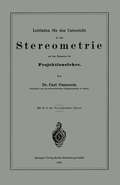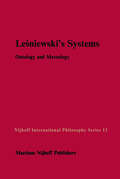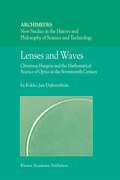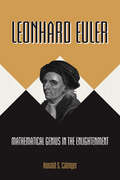- Table View
- List View
Leitfaden für den Unterricht in der Stereometrie mit den Elementen der Projektionslehre
by Carl GusserowLeitfaden Geometrie: Für Studierende der Lehrämter
by Ralf Benölken Hans-Joachim Gorski Susanne Müller-PhilippDer Leitfaden Geometrie gibt eine Einführung in verschiedene Aspekte unter denen Geometrie betrieben werden kann. Er kann als „Lesebuch“, vor allem aber als „Arbeitsbuch“ zum angeleiteten Entdecken von Geometrie benutzt werden. Das Buch ist als vorlesungsbegleitende Lektüre ebenso geeignet wie zum Selbststudium.Diese erweiterte 7. Auflage enthält zahlreiche Ergänzungen. Vor allem wurden die Übungsaufgaben neu gestaltet und 68 Seiten mit Lösungshinweisen bzw. Musterlösungen hinzugefügt.
Leitfaden Geometrie: Für Studierende der Lehrämter
by Hans-Joachim Gorski Susanne Müller-PhilippDer Leitfaden Geometrie führt Lehramtsstudierende in zentrale Teilgebiete der Geometrie ein. Durchgängige Orientierung an Erkenntnissen der Lernpsychologie und Textproduktion, beispielorientiertes Entdecken mathematischer Sätze und Beweise, Motivation durch interessante Quereinstiege und vielfältige Bezüge zu Alltagsfragestellungen kennzeichnen die Konzeption des Leitfadens Geometrie.In der vorliegenden 6. Auflage wurde das Übungsangebot vergrößert und weitere Hinweise zum selbständigen und vernetzenden Lernen eingefügt.
Leitfaden Geometrie: Für Studierende der Lehrämter (Mathematik für das Lehramt)
by Susanne Müller-Philipp Hans-Joachim GorskiDer Leitfaden Geometrie gibt für Studierende der Primarstufe oder des Sekundarbereichs I eine Einführung in die Teilgebiete Topologie, Körper, euklidische Geometrie, darstellende Geometrie, Axiomatik und Abbildungsgeometrie. Der Text ist für die 2. Auflage an einigen Stellen verbessert worden, die Anregungen aus den zahlreichen Zuschriften wurden eingearbeitet und das Layout und die Abbildungen wurden verschönert.
Leitfaden Geometrie: Für Studierende der Lehrämter
by Susanne Müller-Philipp Hans-Joachim GorskiDer Leitfaden Geometrie gibt für Studierende der Primarstufe oder des Sekundarbereichs I eine Einführung in die Teilgebiete Topologie, Körper, euklidische Geometrie, darstellende Geometrie, Axiomatik und Abbildungsgeometrie. Der Text wurde für die 3. Auflage sorgfältig durchgesehen und verbessert.
Leitfaden Geometrie: Für Studierende der Lehrämter
by Susanne Müller-Philipp Hans-Joachim GorskiDer Leitfaden Geometrie gibt für Studierende der Primarstufe oder des Sekundarbereichs I eine Einführung in die Teilgebiete Topologie, Körper, euklidische Geometrie, darstellende Geometrie, Axiomatik und Abbildungsgeometrie.
Leitfaden Geometrie: Für Studierende der Lehrämter
by Susanne Müller-Philipp Hans-Joachim GorskiDer Leitfaden Geometrie gibt für Studierende der Primarstufe oder des Sekundarbereichs I eine Einführung in die Teilgebiete Topologie, Körper, euklidische Geometrie, darstellende Geometrie, Axiomatik und Abbildungsgeometrie. Der Text wurde für die 4. Auflage sorgfältig durchgesehen und verbessert.
Leitfaden Geometrie: Für Studierende der Lehrämter
by Susanne Müller-Philipp Hans-Joachim GorskiDer Leitfaden Geometrie gibt für Studierende der Primarstufe oder des Sekundarbereichs I eine Einführung in die Teilgebiete Topologie, Körper, euklidische Geometrie, darstellende Geometrie, Axiomatik und Abbildungsgeometrie. Während sich die Ausführungen zur Abbildungsgeometrie durchgängig an einem axiomatischen Aufbau orientieren, werden die Darstellungen zu den anderen Teilgebieten im Hinblick auf die Zielgruppe primär durch interessante Quereinstiege, Alltagsfragestellungen und -probleme motiviert.
Leitfaden Stochastik: Für Studierende und Ausübende des Lehramts
by Andreas Eichler Markus VogelIn dem Buch werden die fachlichen Grundlagen beschrieben, die für den Stochastik-Unterricht in der Sekundarstufe I zentral sind. Damit beschränkt sich das Buch auf elementare Konzepte der beschreibenden Analyse von Daten und wird ergänzt durch Grundkonzepte der Wahrscheinlichkeitsrechnung. Diese Konzepte werden ausführlich anhand eines durchgehenden Datensatzes beschrieben. Der Sinn der Konzepte, Vor- und Nachteile, Möglichkeiten und Grenzen von Methoden werden beispielgebunden erläutert und mit Übungen versehen.
Leitidee Daten und Zufall: Von konkreten Beispielen zur Didaktik der Stochastik
by Andreas Eichler Markus VogelDie Leitidee „Daten und Zufall“ stellt einen der fünf Inhaltsbereiche dar, die für den Mathematikunterricht in der Sekundarstufe I maßgeblich und aufgrund der Bildungsstandards bundesweit verbindlich sind. Wie aber kann man diese Leitidee mit Leben füllen? Wie kann man Statistik und Wahrscheinlichkeitsrechnung zu der einen Leitidee Daten und Zufall für die Schule verknüpfen? Das Buch "Leitidee Daten und Zufall" für die Sekundarstufe I gibt hierauf unterrichtspraktische und didaktisch-methodische Antworten. Es geht von konkreten unterrichtsrelevanten Problemstellungen aus und entfaltet an diesen die aktuellen Fragen der Stochastikdidaktik. Über tragfähige Beispiele werden inhalts- und prozessbezogene Standards zur Stochastik vernetzt, um lebensnahe statistische Phänomene im Unterricht erfahrbar werden zu lassen.
Leitidee Daten und Zufall: Von konkreten Beispielen zur Didaktik der Stochastik
by Andreas Eichler Markus VogelDie Leitidee „Daten und Zufall“ stellt einen der fünf Inhaltsbereiche dar, die für den Mathematikunterricht in der Sekundarstufe I maßgeblich und aufgrund der Bildungsstandards bundesweit verbindlich sind. Wie aber kann man diese Leitidee mit Leben füllen? Wie kann man Statistik und Wahrscheinlichkeitsrechnung zu der einen Leitidee Daten und Zufall für die Schule verknüpfen? Das Buch "Leitidee Daten und Zufall" für die Sekundarstufe I gibt hierauf unterrichtspraktische und didaktisch-methodische Antworten. Es geht von konkreten unterrichtsrelevanten Problemstellungen aus und entfaltet an diesen die aktuellen Fragen der Stochastikdidaktik. Über tragfähige Beispiele werden inhalts- und prozessbezogene Standards zur Stochastik vernetzt, um lebensnahe statistische Phänomene im Unterricht erfahrbar werden zu lassen.
Leitprogramm Mathematik für Physiker 1 (Springer-Lehrbuch)
by Klaus WeltnerDas Lehrbuch bietet umfangreiche Anleitungen und Übungsaufgaben zum Band „Mathematik für Physiker“ desselben Autors. Die Studienanleitungen mit Fragen und Kontrollaufgaben erleichtern das eigenständige Erarbeiten des Stoffs. In zusätzlichen Erläuterungen vertieft der Autor einzelne Themenfelder und geht auf individuelle Lernschwierigkeiten ein. Das Buch enthält über 800 Aufgaben mit ausführlichen Lösungen, es ist der ideale Begleiter für Bachelor-Studierende der Physik und der Ingenieurwissenschaften während des ersten Semesters.
Leitprogramm Mathematik für Physiker 2 (Springer-Lehrbuch)
by Klaus WeltnerDas Lehrbuch bietet umfangreiche Anleitungen und Übungsaufgaben zum Band „Mathematik für Physiker“ desselben Autors. Die Studienanleitungen mit Fragen und Kontrollaufgaben erleichtern Lesern das eigenständige Erarbeiten des Stoffs. In zusätzlichen Erläuterungen vertieft der Autor einzelne Themenfelder und geht auf individuelle Lernschwierigkeiten ein. Band 2 des Übungswerks enthält über 700 Aufgaben mit ausführlichen Lösungen und ist der ideale Begleiter für Bachelor-Studierende der Physik während des zweiten Semesters.
Lengths, Widths, Surfaces: A Portrait of Old Babylonian Algebra and Its Kin (Sources and Studies in the History of Mathematics and Physical Sciences)
by Jens HøyrupIn this examination of the Babylonian cuneiform "algebra" texts, based on a detailed investigation of the terminology and discursive organization of the texts, Jens Høyrup proposes that the traditional interpretation must be rejected. The texts turn out to speak not of pure numbers, but of the dimensions and areas of rectangles and other measurable geometrical magnitudes, often serving as representatives of other magnitudes (prices, workdays, etc...), much as pure numbers represent concrete magnitudes in modern applied algebra. Moreover, the geometrical procedures are seen to be reasoned to the same extent as the solutions of modern equation algebra, though not built on any explicit deductive structure.
Leśniewski’s Systems: Ontology and Mereology (Nijhoff International Philosophy Series #13)
by Janusz CzelakowskiLeśniewski's Systems of Logic and Foundations of Mathematics (Trends in Logic #37)
by Rafal UrbaniakThis meticulous critical assessment of the ground-breaking work of philosopher Stanislaw Leśniewski focuses exclusively on primary texts and explores the full range of output by one of the master logicians of the Lvov-Warsaw school. The author’s nuanced survey eschews secondary commentary, analyzing Leśniewski's core philosophical views and evaluating the formulations that were to have such a profound influence on the evolution of mathematical logic. One of the undisputed leaders of the cohort of brilliant logicians that congregated in Poland in the early twentieth century, Leśniewski was a guide and mentor to a generation of celebrated analytical philosophers (Alfred Tarski was his PhD student). His primary achievement was a system of foundational mathematical logic intended as an alternative to the Principia Mathematica of Alfred North Whitehead and Bertrand Russell. Its three strands—‘protothetic’, ‘ontology’, and ‘mereology’, are detailed in discrete sections of this volume, alongside a wealth other chapters grouped to provide the fullest possible coverage of Leśniewski’s academic output. With material on his early philosophical views, his contributions to set theory and his work on nominalism and higher-order quantification, this book offers a uniquely expansive critical commentary on one of analytical philosophy’s great pioneers.
Leśniewski’s Systems Protothetic (Nijhoff International Philosophy Series #54)
by Jan J. T. Srzednicki Z. StachniakBetween the two world wars, Stanislaw Lesniewski (1886-1939), created the famous and important system of foundations of mathematics that comprises three deductive theories: Protothetic, Ontology, and Mereology. His research started in 1914 with studies on the general theory of sets (later named `Mereology'). Ontology followed between 1919 and 1921, and was the next step towards an integrated system. In order to combine these two systematically he constructed Protothetic - the system of `first principles'. Together they amount to what Z. Jordan called `... most thorough, original, and philosophically significant attempt to provide a logically secure foundation for the whole of mathematics'. The volume collects many of the most significant commentaries on, and contributions to, Protothetic. A Protothetic Bibliography is included.
Lenses and Waves: Christiaan Huygens and the Mathematical Science of Optics in the Seventeenth Century (Archimedes #9)
by Fokko Jan DijksterhuisIn 1690, Christiaan Huygens (1629-1695) published Traité de la Lumière, containing his renowned wave theory of light. It is considered a landmark in seventeenth-century science, for the way Huygens mathematized the corpuscular nature of light and his probabilistic conception of natural knowledge. This book discusses the development of Huygens' wave theory, reconstructing the winding road that eventually led to Traité de la Lumière. For the first time, the full range of manuscript sources is taken into account. In addition, the development of Huygens' thinking on the nature of light is put in the context of his optics as a whole, which was dominated by his lifelong pursuit of theoretical and practical dioptrics. In so doing, this book offers the first account of the development of Huygens' mathematical analysis of lenses and telescopes and its significance for the origin of the wave theory of light. As Huygens applied his mathematical proficiency to practical issues pertaining to telescopes – including trying to design a perfect telescope by means of mathematical theory – his dioptrics is significant for our understanding of seventeenth-century relations between theory and practice. With this full account of Huygens' optics, this book sheds new light on the history of seventeenth-century optics and the rise of the new mathematical sciences, as well as Huygens' oeuvre as a whole. Students of the history of optics, of early mathematical physics, and the Scientific Revolution, will find this book enlightening.
Leo Esakia on Duality in Modal and Intuitionistic Logics (Outstanding Contributions to Logic #4)
by Guram BezhanishviliThis volume is dedicated to Leo Esakia's contributions to the theory of modal and intuitionistic systems. Consisting of 10 chapters, written by leading experts, this volume discusses Esakia’s original contributions and consequent developments that have helped to shape duality theory for modal and intuitionistic logics and to utilize it to obtain some major results in the area.Beginning with a chapter which explores Esakia duality for S4-algebras, the volume goes on to explore Esakia duality for Heyting algebras and its generalizations to weak Heyting algebras and implicative semilattices. The book also dives into the Blok-Esakia theorem and provides an outline of the intuitionistic modal logic KM which is closely related to the Gödel-Löb provability logic GL. One chapter scrutinizes Esakia’s work interpreting modal diamond as the derivative of a topological space within the setting of point-free topology. The final chapter in the volume is dedicated to the derivational semantics of modal logic and other related issues.
Leonardo da Vinci’s Giant Crossbow
by Matt LandrusAlthough Leonardo’s Giant Crossbow is one of his most popular drawings, it has been one of the least understood. "Leonardo’s Giant Crossbow" offers the first in-depth account of this drawing’s likely purpose and its highly resolved design. This fascinating book has a wealth of technical information about the Giant Crossbow drawing, as it’s a complete study of this project, though this is as accessible to the general audience as much as it is also informative with new discoveries for the professors of engineering, technology and art. The book explores the context of Leonardo’s invention with an examination of the extensive documentary evidence, a short history of the great crossbow and ballista, the first accurate translation of the text and the technical specifications, and a detailed analysis of Leonardo’s design process for the crossbow, from start to finish. Dozens of preparatory drawings, along with the recent discovery of nearly invisible metal stylus preparatory incisions under the ink of the Giant Crossbow drawing, are evidence of Leonardo’s intent to offer engineers and other viewers a thorough design of the massive machine. The book proposes these new discoveries with the help of a strategy that had been at the core of Leonardo’s working philosophy: the proportional method. As proven with an analysis of the Giant Crossbow project, he used a consistent approach to 1/3rd proportions throughout the design and drawing process and employed this kind of proportional strategy at the start of almost every important project. Thanks to this proof of his knowledge of geometry, evidence of his studies of impetus and force, and thanks to the highly polished and complex nature of the Giant Crossbow design, a later date for the drawing is proposed in the present book, associating the drawing with his drafting capabilities around 1490-93.
Leonhard Euler: Mathematical Genius in the Enlightenment
by Ronald S. CalingerThis is the first full-scale biography of Leonhard Euler (1707–83), one of the greatest mathematicians and theoretical physicists of all time. In this comprehensive and authoritative account, Ronald Calinger connects the story of Euler's eventful life to the astonishing achievements that place him in the company of Archimedes, Newton, and Gauss. Drawing chiefly on Euler’s massive published works and correspondence, which fill more than eighty volumes so far, this biography sets Euler’s work in its multilayered context—personal, intellectual, institutional, political, cultural, religious, and social. It is a story of nearly incessant accomplishment, from Euler’s fundamental contributions to almost every area of pure and applied mathematics—especially calculus, number theory, notation, optics, and celestial, rational, and fluid mechanics—to his advancements in shipbuilding, telescopes, ballistics, cartography, chronology, and music theory.The narrative takes the reader from Euler’s childhood and education in Basel through his first period in St. Petersburg, 1727–41, where he gained a European reputation by solving the Basel problem and systematically developing analytical mechanics. Invited to Berlin by Frederick II, Euler published his famous Introductio in analysin infinitorum, devised continuum mechanics, and proposed a pulse theory of light. Returning to St. Petersburg in 1766, he created the analytical calculus of variations, developed the most precise lunar theory of the time that supported Newton’s dynamics, and published the best-selling Letters to a German Princess—all despite eye problems that ended in near-total blindness. In telling the remarkable story of Euler and how his achievements brought pan-European distinction to the Petersburg and Berlin academies of sciences, the book also demonstrates with new depth and detail the central role of mathematics in the Enlightenment.
Leonhard Euler
by Emil A. FellmannEuler was not only by far the most productive mathematician in the history of mankind, but also one of the greatest scholars of all time. He attained, like only a few scholars, a degree of popularity and fame which may well be compared with that of Galilei, Newton, or Einstein. Moreover he was a cosmopolitan in the truest sense of the word; he lived during his first twenty years in Basel, was active altogether for more than thirty years in Petersburg and for a quarter of a century in Berlin. Leonhard Euler’s unusually rich life and broadly diversified activity in the immediate vicinity of important personalities which have made history, may well justify an exposition. This book is based in part on unpublished sources and comes right out of the current research on Euler. It is entirely free of formulae as it has been written for a broad audience with interests in the history of culture and science.
























